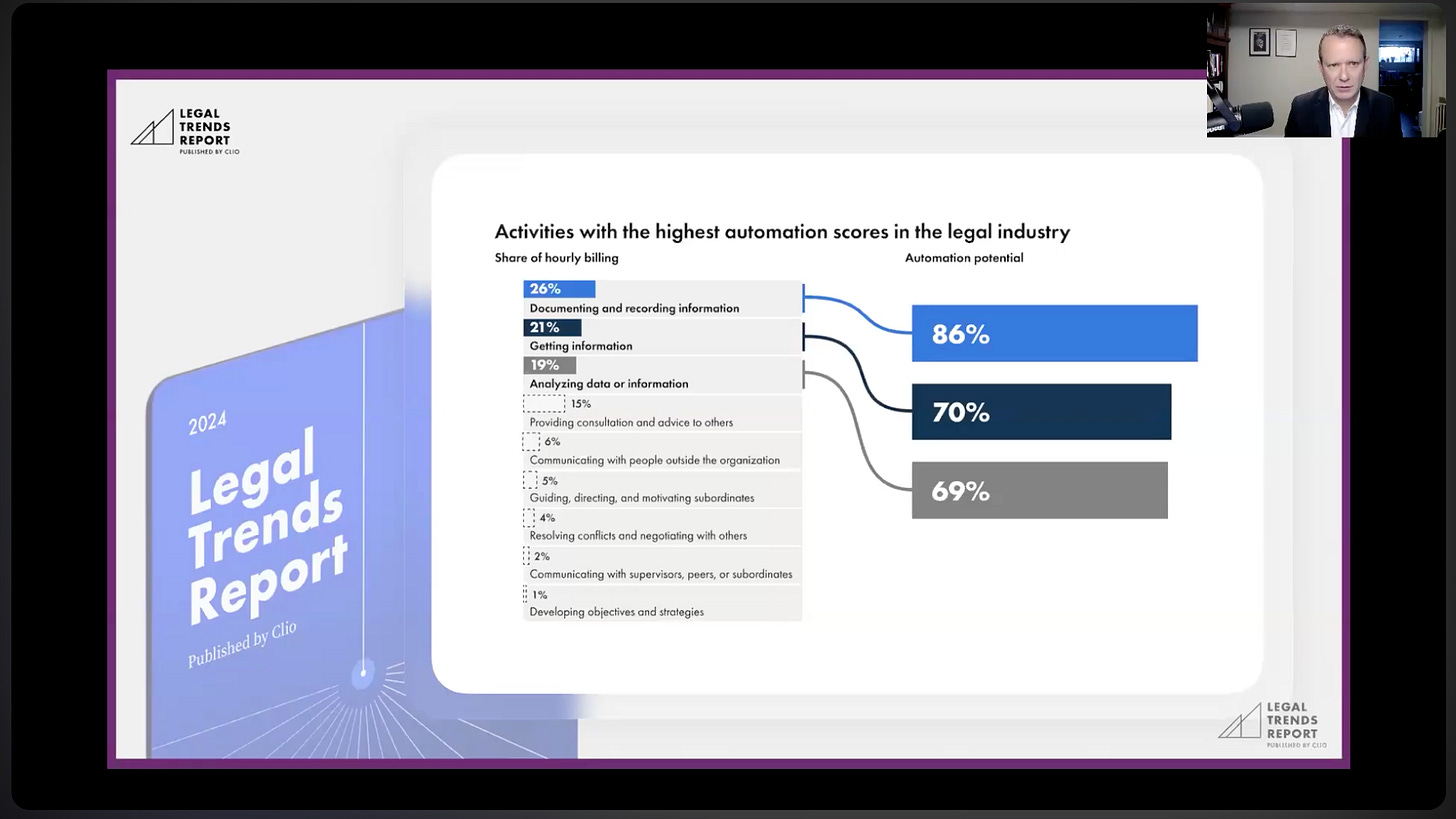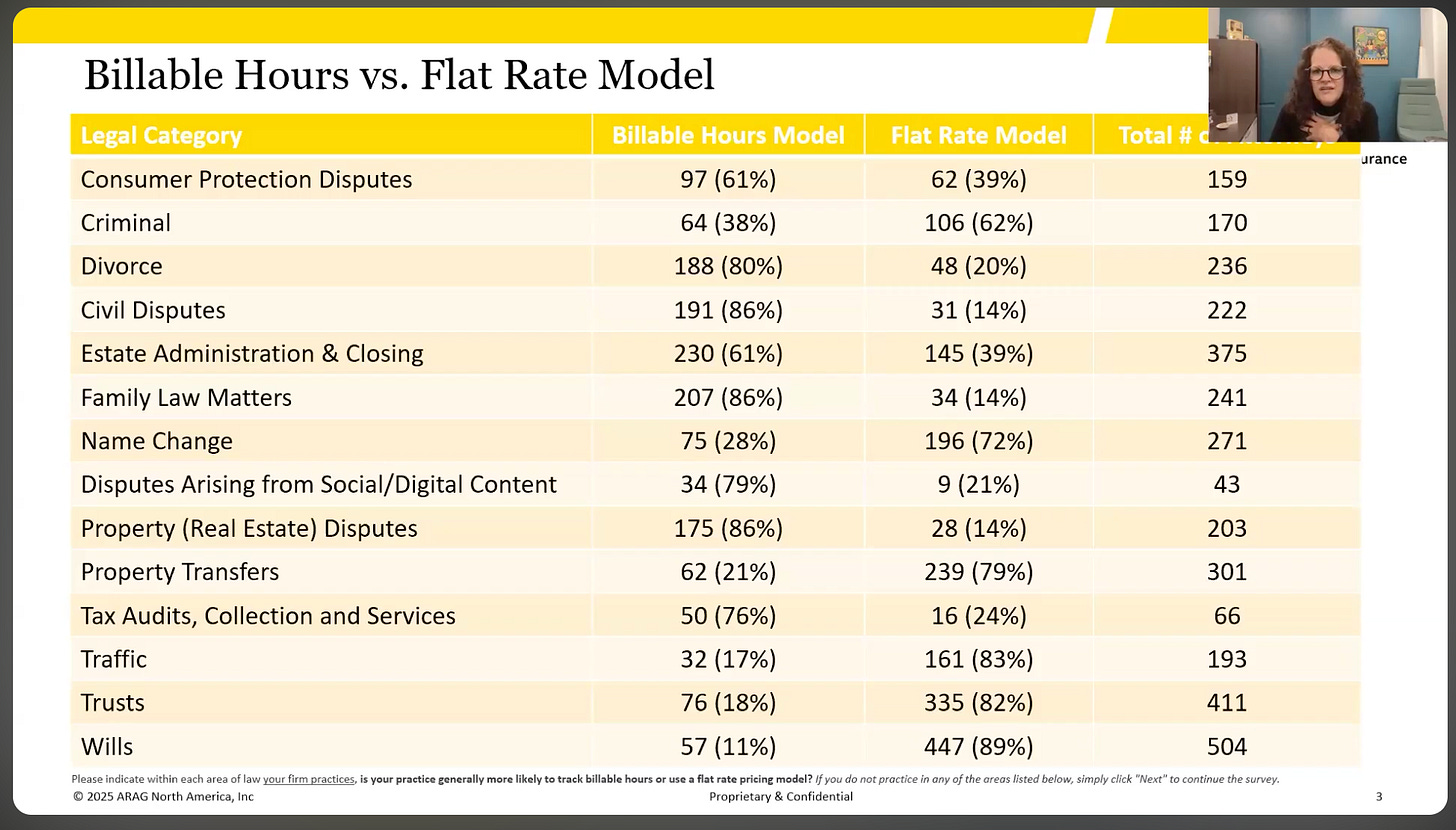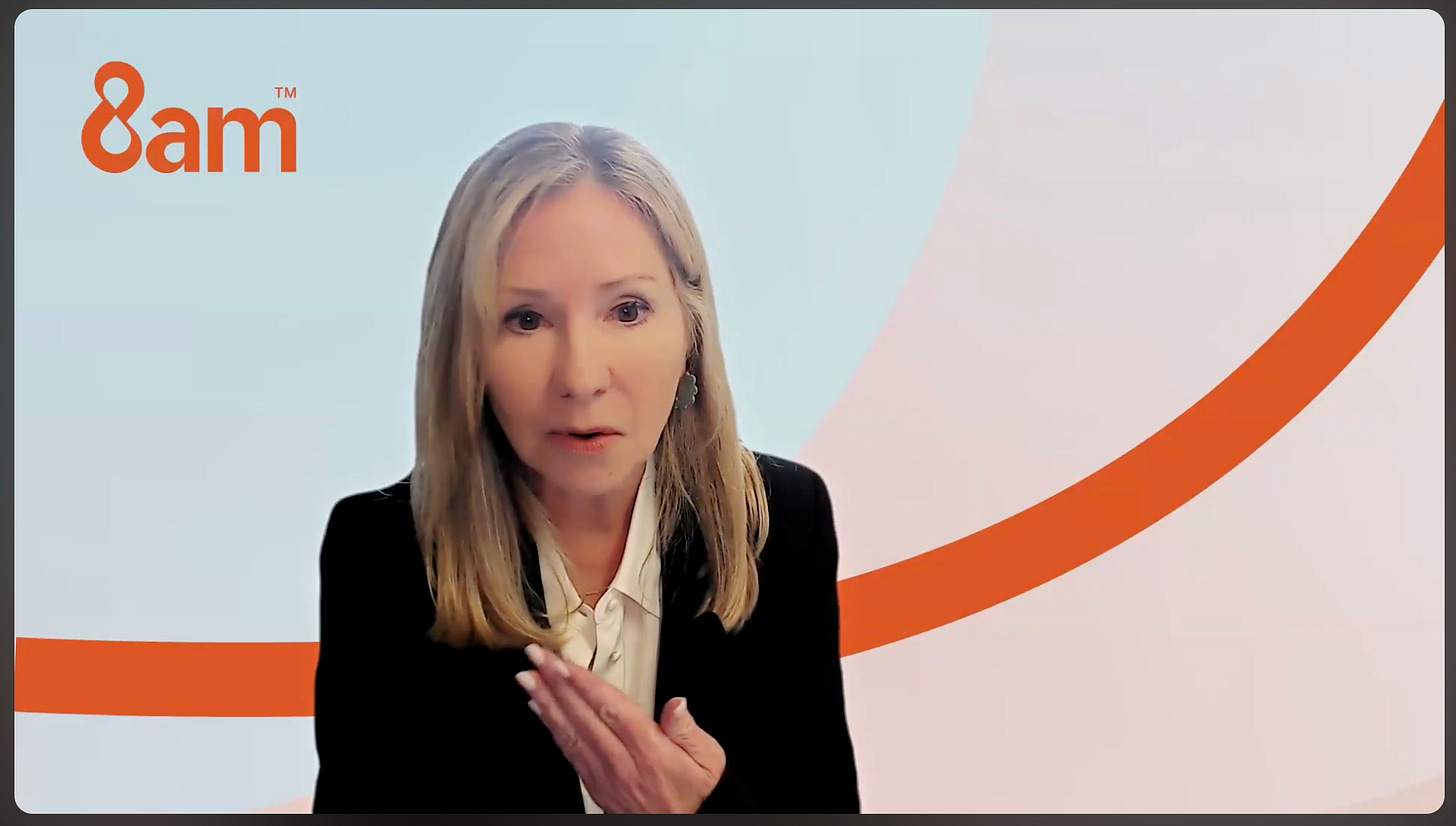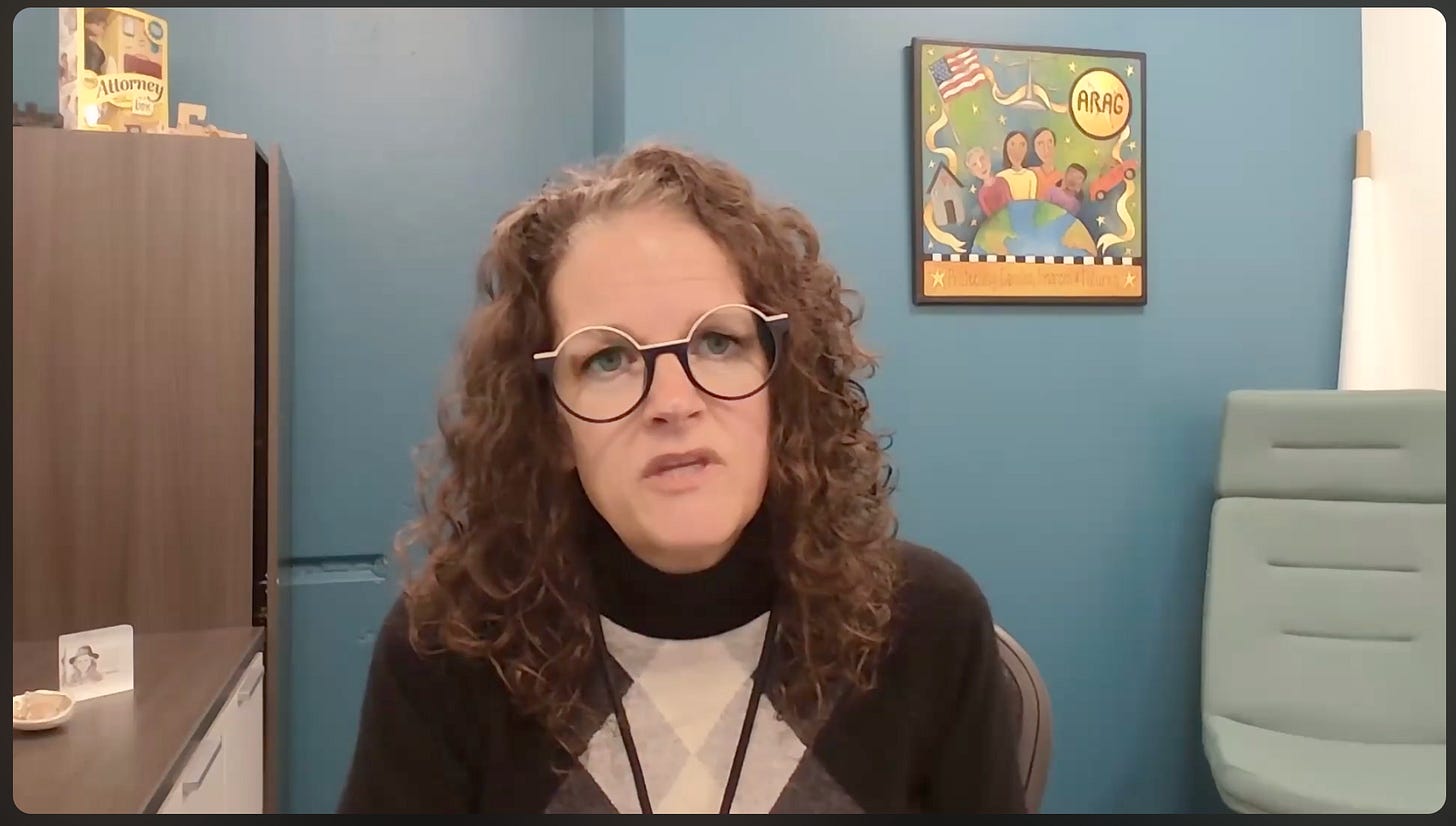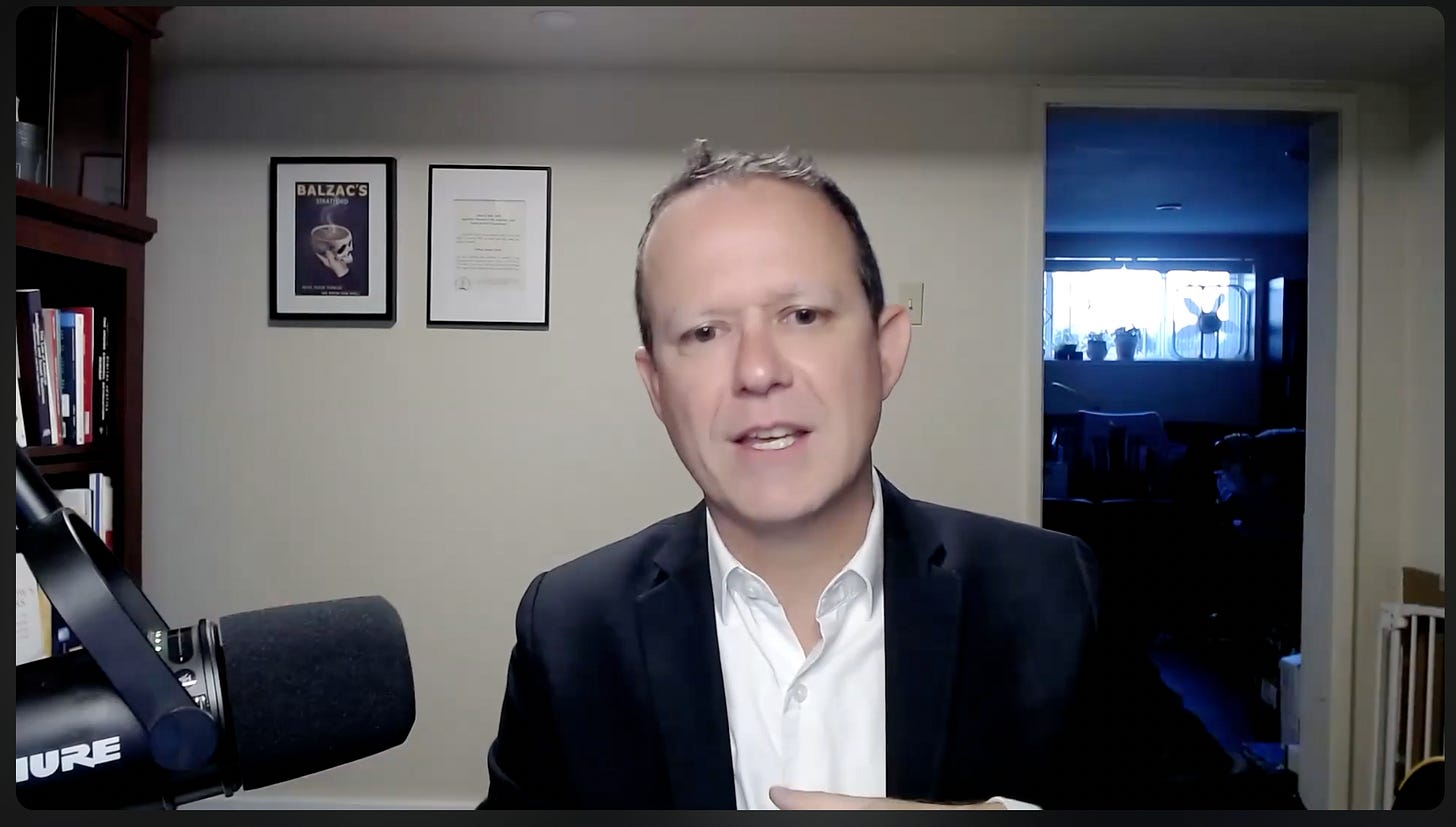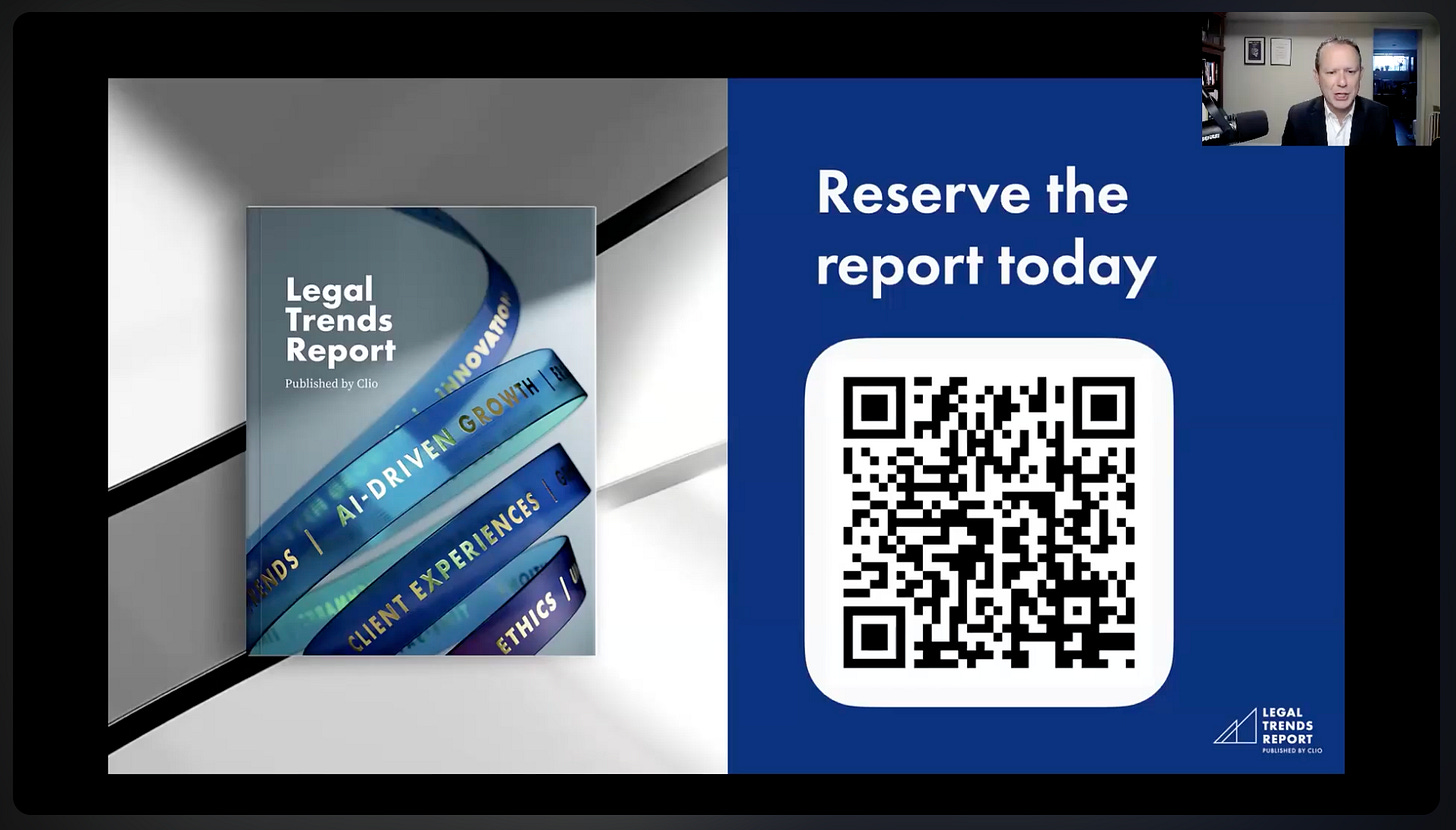The Trillion Dollar Question: How AI Will Reshape Every Law Firm in America
Inside the American Legal Technology Awards panel that revealed the seismic shifts coming to legal practice, and why resistance may be futile
The numbers are stark: 74% of legal work has “strong automation potential.” For the average attorney, that translates to a potential loss of $27,000 in annual billable hours. But as three industry leaders revealed at the 6th annual State of the Industry panel, this isn’t a story about loss, it’s a story about transformation, access, and the widening chasm between lawyers who embrace change and those who don’t.
“AI won’t replace lawyers,” Ann Cosimano declared,
“but lawyers who use AI will likely replace those who don’t.”
On October 7th, the panel, featuring Joshua Lenon of Clio, Ann Cosimano of ARAG, and Catherine Dawson of 8am, and led by Patrick Palace of Palace Law, painted a portrait of an industry at an inflection point, where client expectations are evolving faster than most firms can adapt, where the billable hour faces an existential crisis, and where technology companies are no longer service providers but partners in defending the rule of law itself.
A Decade of Digital Transformation
Joshua Lenon: The Legal Trends
Joshua Lenon, lawyer in residence at Clio and employee number 83 (a distinction he was quick to correct), came armed with a decade’s worth of data that reads like a chronicle of an industry in slow-motion disruption.
Celebrating his 13th work anniversary at Clio, Lenon unveiled exclusive insights from the company’s 10th annual Legal Trends Report, a data set drawn from tens of thousands of legal professionals across 108 countries. The findings tell a story of persistent gaps between expectation and reality.
The Expectation Gap (2018): Lawyers believed 90% of clients wanted to discuss cases via email or phone. Reality? 70% of clients demanded face-to-face meetings. The disconnect was profound.
The Response Crisis (2019): A secret shopper exercise revealed that 79% of consumers expect responses within 24 hours. Miss that window, and you’ve likely lost the client. A 2024 follow-up showed 78% of secret shoppers would not recommend the firms they contacted, primarily due to lack of response or information.
The Technology Premium (2023): Law firms accepting electronic payments got paid faster. But firms that went further, offering payment plans and flexible arrangements, saw realization rates climb and collection rates soar. Payment plans alone generated a 43% revenue bump on average; for solo practitioners, that number jumped to 70%. The average monthly payment? A modest $400, “evidence,” Lenon noted, “of what might be affordable access to legal representation.”
The AI Reckoning (2024): Then came the bombshell. Analyzing over 7 million time entries, Clio found that 74% had strong automation potential. The three highest categories, documenting information (drafting), getting information (client communication and research), and analyzing data, accounted for 66% of all time entries. These are core activities and AI can now handle much of the heavy lifting.
“If law firms actually leaned in and maximized this automation,” Lenon explained, “the average law firm would see a potential loss of $27,000 per lawyer, annually, because of lost billable time.”
But Lenon’s message wasn’t one of doom.
The forthcoming 2025 report, he teased, would examine three critical areas:
responsible law firm finances (a new lens on productivity and scalability)
the measurable financial impact of AI adoption; and
the impact of AI on lawyers themselves.
Ann Cosimano: The Network Effect
Ann Cosimano brought a different perspective to the table: the view from 15,000 attorneys working in the trenches of access to justice.
As General Counsel of ARAG, a legal insurance company serving Fortune 100 and 500 companies for over 50 years, Cosimano oversees a network that functions much like dental or vision insurance, employees enroll as a benefit, then access network attorneys when legal issues arise.
The statistics she shared reveal an industry still dominated by solo and small firms, supported by lean staffs, operating under increasing pressure from client expectations. “The number one thing we hear from member expectations,” she reported, “is that if those attorneys don’t pick up the phone, they move on to the next attorney on our list.” The attorney who answers first wins the client.
ARAG’s annual attorney survey revealed significant movement toward flat-fee arrangements, particularly in transactional areas. While family law still leans on billable hours due to unpredictability, the trend is clear: as AI tools enable greater efficiency, more attorneys are exploring alternative billing structures to capture that value.
Social Media Blind Spots: Facebook remains the dominant platform for attorney social media presence, a disconnect from where consumers, particularly younger ones, spend their time. “I did expect to see some of the other social media channels increase,” Cosimano admitted, “and follow more what consumers are seeing.”
AI Adoption Barriers: According to ABA survey data that aligned closely with ARAG’s findings, 31% of attorneys now personally use generative AI at work (up from 27% the previous year). ChatGPT leads adoption, followed by CoCounsel and Lexis. But the barriers remain formidable: data privacy and confidentiality top the list, followed by cost and the need for better education. Notably, AI hallucinations, despite generating courtroom horror stories, ranked lower as a concern than expected.
The adoption gap between large firms and solo practitioners is stark, likely reflecting resource disparities. Large firms can invest in enterprise AI solutions with built-in guardrails; solo practitioners often can’t afford the premium versions that would give them confidence to use these tools with client data.
Catherine Dawson: The Platform Perspective
Catherine Dawson, Chief Legal Officer of 8am (parent company of LawPay, MyCase, DocketWise, and Casepeer), brought the perspective of someone who has lived on both sides, first half of her career in Big Law, second half as general counsel to technology companies.
The August 2024 rebrand to 8am wasn’t just cosmetic; it reflected a fundamental shift in how the company views itself. “People were thinking of us as disparate products,” Dawson explained, “and we really wanted a way to let our customers know and utilize our different solutions across the platform.”
The Business Crisis: 8am’s survey of 3,000 solo and small firms revealed a profession struggling with the business fundamentals. 68% have trouble collecting fees (a number Dawson found surprisingly low, “I think it’s a really hard part of owning a law firm”). 61% struggle with accounting, particularly the critical IOLTA trust accounting. 55% have trouble with expense tracking.
“Being a law firm owner is… you’re running a business, and you didn’t go to law school to run a business, and it’s hard to get those skills,” Dawson noted. This is where technology can provide immediate value, even before touching the practice of law.
The AI Efficiency Dividend: Among 8am customers using AI, 82% report increased efficiency. 65% save 1-5 hours per week; 12% save 6-10 hours. “That efficiency, and then what to do with that savings,” Dawson observed, “is a key question.”
She spoke from experience: “I use [AI] daily in my practice. And so does my team.” As both a legal tech executive and an in-house counsel who hires outside firms, she has strong opinions about billing. “I love a flat fee arrangement… it really is helpful to my budget to be able to predict what those monthly costs are gonna be.”
The Access to Justice Multiplier: Firms offering flexible fee arrangements, particularly “pay later” options, report being able to take on significantly more cases, 47% more, according to 8am’s data. “You can take on more kinds of cases, more cases, than you might not have been able to otherwise, and help end clients who might not have been able to afford it,” Dawson explained.
The Five Forces Reshaping Legal Practice
1. The Client Expectation Revolution
The “Amazon effect” has arrived in full force. Clients now expect real-time updates, instant responses, transparent pricing, and the ability to track their legal matters like they track packages. The 24-hour response window isn’t a suggestion, it’s a requirement for survival.
“We’re all consumers, and probably most of us on Amazon,” Dawson noted, “but it’s so… we’re so used to being able to track our package and know what’s happening with the things that we are consuming at every stage of the game. And so I think clients of law firms have the same expectations.”
2. The Technology Adoption Dividend
The data shows a clear pattern: firms that embrace technology, electronic payments, online scheduling, client portals, automated intake, consistently outperform those that don’t. Lenon’s research showed firms using three key features (online schedulers, links to search ads, and online intake forms) saw 51% more client leads and 52% more revenue.
Technology adoption isn’t just about efficiency; it’s about client acquisition and retention in an increasingly competitive market.
3. The AI Transformation
AI adoption is accelerating but remains uneven. The legal profession is following a pattern seen in other industries: early adopters gain advantages, while resisters fall behind. But the stakes are higher in law, client confidentiality, ethical obligations, and potential malpractice create real barriers to careless adoption.
The sweet spot appears to be purpose-built legal AI tools with robust data protection, not free consumer tools repurposed for legal work.
4. The Billing Model Crisis
The billable hour is under siege. As AI automates routine tasks, the traditional time-based billing model becomes increasingly untenable. Clients don’t want to pay for work that could be automated. Large firms, deeply invested in the billable hour model, face particular challenges.
“I can’t pay for time that I shouldn’t be paying for,” Dawson said bluntly. “I just don’t have the budget, and I don’t have the time.”
5. The Access to Justice Opportunity
Perhaps the most optimistic theme: technology, and AI in particular, may finally offer real solutions to the access to justice crisis. Payment plans, efficient workflows, automated intake, and AI-assisted research can help firms serve more clients at lower price points while maintaining profitability.
“AI gives the tools that maybe we could have some real solutions to this problem that’s been a problem for years,” Cosimano observed.
Seven Critical Questions
On Lawyers Who Resist AI
The Question: What do you see for lawyers adopting AI versus those who resist?
Dawson’s Perspective: Give yourself grace, but start experimenting, in your personal life first. “Plan a trip, plan, you know, find restaurants near museums that you want to go to on your next… like, those kinds of ways will sort of supercharge your comfortability with it.” She pointed to ethical obligations: “Maybe you have an ethical obligation to use technology, right? Like, are you providing reasonable representation to your clients if you’re not taking advantage of the resources at your disposal?”
Lenon’s Business Case: Try AI in business contexts before practice contexts. “I have a website, I want to make sure it is readable to someone with a high school education. GenAI, can you take a look at my website and recommend copy changes?” Start with low-risk, high-utility applications. Build confidence. Learn the back-and-forth required to get quality output.
Cosimano’s Warning: The market will decide. “Consumers have expectations that are rapidly evolving. And they are going to move on to another lawyer who can do the same work more efficiently.” She invoked the corporate mortality of companies that failed to iterate: “There are several examples of those that resisted the newest form of iteration that have then gone by the wayside.”
On Firms That Ban AI
The Question: What’s your advice to law firms and to courts banning AI?
Cosimano: “AI won’t replace lawyers, but lawyers who use AI will likely replace those who don’t.” She expressed concern about firms married to the billable hour: “If you live and die by the billable hour, your consumers have expectations that are rapidly evolving.”
Lenon: “If the client’s saying no AI, no AI. That’s the client’s prerogative.” But if it’s firm policy, not client preference? “You have a problem, because you have shadow IT happening… your employees go out and they get their own tools, because you’re not providing them. And so AI’s already there. You just don’t know it and can’t make sure it’s being used responsibly. So it’s there. Bring it out of the shadows.”
Dawson: On the judiciary: “Talk to your law clerks. You know, get their opinion, have them play around.” On law firms: “I can’t hire you. I can’t pay for time that I shouldn’t be paying for… My team uses it, we use it before we reach out to outside counsel.”
On Safely Using Embedded AI
The Question: For lawyers who don’t know where AI is embedded in their tools, how can they use it safely and ethically?
Dawson’s Guidance: “Review the terms of service… you are looking for whether or not it uses your input to train the model. And if it does, you cannot put customer or client information, or data, or anything… I just wouldn’t use the tool, frankly.”
The free tools are the danger zone. “You gotta pay a little bit extra to make sure you’re not training the model and exposing your data.”
Lenon’s Framework: Look to legal technology vendors for specialized use cases, especially with confidential data. “They have those contractual terms that you need. They should have transparency around that as well… that’s not something you can necessarily easily get from commercial or consumer tools.”
The reputation consideration: “We’re a reputation industry, legal technology, right? We can’t afford to get it wrong.”
On Balancing Efficiency with Revenue
The Question: How do lawyers bridge the gap between AI-driven efficiency (serving more clients, improving access to justice) and lost billable hours?
Cosimano’s Volume Model: The shift: from depth to breadth. “It’s going to probably come down to encouraging attorneys to view their model on being able to do more of a volume business than being able to go deep on any one account. If you’re able to do volume and do it at flat fee, then you can do that more reasonably, and you’re also bridging that access to justice, so being able to serve more people with the time that you have at a more affordable cost.”
Lenon’s Addition: “AI gives the tools that maybe we could have some real solutions to this problem that’s been a problem for years. The courts, I think, are going to be some of the first to try to embrace it.”
Dawson’s Alternative Staffing: Leverage AI to reimagine staffing models. She cited Bob Simon, a California personal injury lawyer who built his own LLM and uses AI for initial client intake, then employs “closers,” offshore English-speaking staff who follow up once AI completes the intake. “I think it’s a perfect example of leveraging different staffing models, and I think being open to that is sort of a key to unlock the value and efficiency with AI.”
On Unauthorized Practice of Law
The Question: Is UPL a concept that needs to evolve or die in the age of ChatGPT?
Cosimano’s Pragmatism: She invoked the parallel to limited scope representation, once controversial, now standard. “The thing that I always think of is, if a chatbot can help somebody avoid eviction, would we stop it because it’s not a lawyer?”
The moral calculus is clear: “Would we say that that person has the alternative… get evicted… or they have to see a lawyer? No, I mean, I think everybody thinks common sense access to tools that can help avoid those types of issues makes sense.”
Dawson’s Nuance: “There are law books in the library, right? You can go to the public library and pull down some law books and learn about various topics, and I think this will feel a little bit like that. But certainly, obviously, more accessible.”
On Professional Responsibility in Uncertain Times
The Question: What duty does legal tech have to support lawyers’ obligations to uphold constitutional principles, judicial independence, and the rule of law?
Lenon’s Call to Action: “There’s a trend amongst lawyers and legal tech to apologize for being lawyers, or to say, you know, I’m a recovering lawyer. And I don’t think that’s the case at all. I think we’re still officers of the court.”
He emphasized that lawyers in legal tech retain their professional obligations, whether representing a company or serving as the voice of customers. “We do have a requirement to take a look at what’s going on in our legal system, making sure that we understand how that might be impacting the technology choices of lawyers and customers, and supporting that to the best extent we can.”
The stakes: “The right to representation is a part of the U.S. Bill of Rights. It is something we know statistically leads to better outcomes, not just for one side, but for all sides.” He cited landlord-tenant cases: both sides benefit from representation.
Cosimano’s Mission Statement: “Access to Justice, it’s all we do, it’s what our process and our company was founded upon, was being able to allow people to assert their legal rights, not just those who can afford it.”
The Choice Ahead
The 6th annual State of the Industry panel revealed an industry at a crossroads. The technology exists to serve more clients, more efficiently, at lower cost. The client expectations are clear. The business model alternatives are proven. The ethical frameworks are emerging.
What remains unclear is whether enough of the profession will adapt quickly enough.
“I always think about companies that didn’t iterate with the times, and where are they now?” Cosimano mused, invoking the corporate graveyard of brands that failed to evolve. Blockbuster. Borders. Kodak. The list is long and cautionary.
But the legal profession isn’t just another industry. It’s also a pillar of democracy, a guardian of rights, an engine of justice. When Lenon insisted that lawyers remain “officers of the court” with obligations that extend beyond profit margins, he articulated something essential: lawyers bear responsibilities that technology companies don’t.
The American Legal Technology Awards will honor those who are trying to make the world more just and fair, with technology. Winners will be announced in 10 categories on October 15, 2025, at Suffolk Law School in Boston, Massachusetts. The event is sold out, though stragglers determined to attend are encouraged to reach out. You can find more information at AmericanLegalTechnology.com.
Be the innovator. Be the lawyer who picks up the phone. Be the firm that figures out payment plans and flexible billing. Be the practitioner who learns to use AI responsibly. Be the voice advocating for access to justice in your community.
As Patrick Palace put it, the onus is on us: “We are the people we’ve been waiting for.” And the work starts now.
See you in Boston!
For more information, visit AmericanLegalTechnology.com. The award ceremony takes place October 15, 2025, at Suffolk Law School in Boston, Massachusetts. Many thanks to our sponsors: 8am, ARAG, and Clio. 🙏



